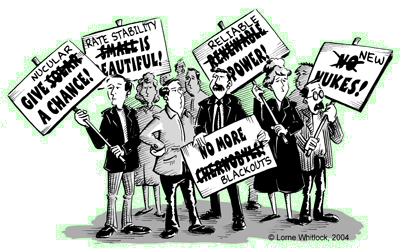Published in the March 2004
issue of the Canadian
Nuclear Society Bulletin, Vol.25, No.1. Artwork
by Lorne Whitlock.
Split Atoms, Not Infinitives by Jeremy Whitlock The year was 1989. For Lorne McConnell, then Ontario Hydro's planning VP, it was a fitting swan song to a career of leadership within the giant utility. Thirty years earlier he had quarterbacked the province, and the entire country, into the Nuclear Power Age as NPD's first station superintendent. The 1989 plan was of course shelved, but fifteen years later many of its elements have returned to the spotlight in the 10-year outlook of Ontario's grid operator (the IEMO), as well as in the recent report of the Ontario Government's Electricity Conservation and Supply Task Force. People are again discussing a multi-unit CANDU build program, plus refurbishment, and this time the prospect has legs. What's so different about 2004, compared to 1989, that turns the optics around so dramatically? Besides the use of the word "optics", that is. Perhaps it's the lack of a hostile NDP government in Toronto. Perhaps it's the lack of a major recession and ten subsequent years of flat demand. Perhaps it's the existence of a private-sector nuclear operator that puts the "Can-do!" back in CANDU. Or an Ontario government with no time for coal. Maybe it's got something to do with a decade of unstable natural gas pricing. Or almost two decades without a major reactor accident anywhere on the planet. How about a sexy new CANDU design ready to take on the world and compete head-to-head with gas, with risk guarantees to boot? Possibly all of these played a role, but there's no denying the one factor deserving most of the credit for waking politicians and the media to the simple realities of electricity supply: Air Conditioning. Last August, for several very humbling hours (days in some cases), nobody in Ontario had any. You see, about five years ago Ontario's summer peak electricity usage surpassed its winter peak for the first time, and hasn't looked back: air conditioning is king in the Land of Plenty. So during the Great Blackout of August 2003, decision makers, news editors, CEOs - society's most elite movers and shakers - all stewed in their own juices just like the most homeless of the homeless, pondering the value of electricity to the social fabric.
People learned what a megawatt can do: their radios told them how many hundreds of these things were coming their way, and then poof - an entire city was alight. Just as quickly, the gift was revoked when too many air conditioners went back on. People learned about supply reliability. They learned how the grid works. They learned that there IS a grid.
Astonishingly, this is exactly what the water-cooler pundits had been advocating for years: "What we need is a good blackout - then people will appreciate what reactors do for them!" That kind of knee-jerk diplomacy never cut it with the serious PR thinkers, but lo and behold, it happened and it had exactly that effect on people. Go figure. Suddenly nuclear is in the "In" basket again. On the evening news, in the editorial columns, a new rational approach appears - nuclear is neither pariah nor panacea, but a strategic baseload option. Long-time industry defenders are baffled by the new tack of reasonable thought. There is but one remaining problem on the nuclear social scene: far too many people are still mispronouncing the word as "nucular". If the technology is to play a larger role in people's lives then it's just going to have to be identified correctly. Unfortunately, this particular verbal negligence is reinforced by many in the industry itself, as well as the high and mighty from George Dubya right back to Eisenhower himself in his "Atoms for Peace" speech to the UN fifty years ago last December. It's been in the Merriam-Webster dictionary since 1961 ("found in widespread use among educated speakers including scientists, lawyers, professors, congressmen, U.S. cabinet members, and at least one U.S. president and one vice president." Most prestigious, it notes, is the usage by "British and Canadian speakers".) Thus, social advocacy still has a role to play in a new era of mainstream nuclear tolerance. Announcing the "Campaign for Nucular Phase-out", dedicated to the eradication of this dastardly vernacular from the common parlance. Send your money today.
| ||||
|
Discussion welcome.
©2011 Jeremy Whitlock
| ||||
|
|

